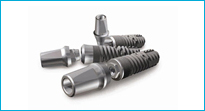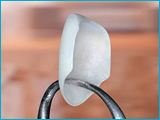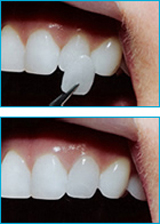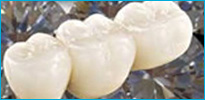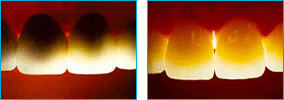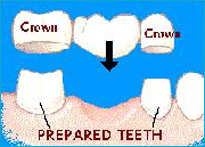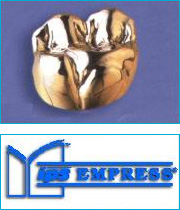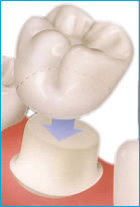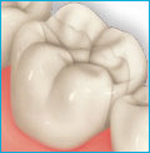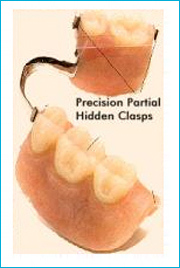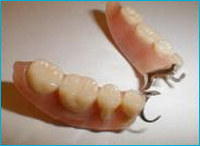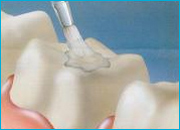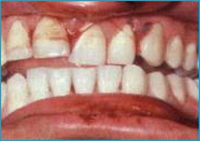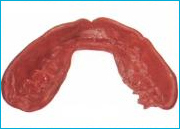- Dental Implants
- Laminates
- Zirconium Crowns
- Ceramic
- Teeth Whitening
- Composite Fillings
- Bondings
- Teeth Straightening
- Dental Bridge
- Gum Treatment
- Captek or Gold Crowns
- Root Canal
- Dentures
- Extractions
- Baby Teeth
- All About Prevention
- Emergencies
- Mouthgaurds
Dental Implants
|
||||||||||||||||||||||||||
|
||||||||||||||||||||||||||
Laminates or Veneers
|
||||||||||||||
| Synopsis | ||||||||||||||
Laminate veneers are a rapid, aesthetic, and safe way to correct unattractive front teeth. Porcelain veneers correct heavy permanent stains, teeth that are crooked, disproportionate, small (with spaces), and structurally damaged. Porcelain veneers are shells of ceramic material that can be chemically bonded to tooth structure |
||||||||||||||
| Technique | ||||||||||||||
|
Zirconium Crowns
Zirconium is rapidly becoming the material of choice for dental crowns. It is a very strong material able to withstand the wear and tear of everyday use. Aesthetically, it is translucent very similar to a natural tooth, reflecting light in much the same way. |
|||
This means that Zirconium are very aesthetic effect, which may be important if your new crowns are to be at the front of your mouth and is particularly relevant in cases where the crowns will be seen beside natural teeth. |
|||
| Porcelain is the traditional material used for new crowns. Full porcelain however may chip or break. This is overcome by making the crowns from metal, in this case the metal being zirconium, then fusing porcelain to the outside. The zirconium metal provides the strength whilst the porcelain provides the outward appearance on a normal tooth. Zirconium crowns allow light to pass through as with a normal tooth giving a natural look, unlike other metal cores which block the light. |
|||
|
|||
|
|||
| Technique | |||
| • Removal of portions of your natural tooth's structure to accommodate the dental crown. | |||
| • A temporary crown will be fitted between visits, while your custom crown is crafted in our labs, from an impression of the original tooth | |||
| • The temporary crown is removed and your new custom dental crown is securely bonded in place. |
Ceramic or Porcelain Crowns
|
|||||||||||||||
Unlike veneers, porcelain crowns cover all surfaces of the tooth and are used only when the tooth is fractured or very broken down. The porcelain used is the same as that used for veneers so they are strong and also offer a aesthetic natural look. Crowns are made to improve your overall smile or to blend in with your own teeth. |
|||||||||||||||
Crowns are also used to support a large filling when there isn't enough of the tooth remaining, attach a bridge, protect weak teeth from fracturing, restore fractured teeth, or cover badly shaped or discolored teeth. Sometimes an underlying metal shell is used under the porcelain if additional strength is needed. |
|||||||||||||||
|
|||||||||||||||
|
|||||||||||||||
The permanent crown will fit considerably better than the temporary crown, so the temporary crown gives little indication of how the final crown will fit or feel. It is important that the temporary crown or bridge stay in place until the final crown or bridge is placed. If the temporary should come off early, please call at the clinic. |
|||||||||||||||
|
|||||||||||||||
|
|||||||||||||||
| Technique | |||||||||||||||
| • Removal of portions of your natural tooth's structure to accommodate the dental crown. | |||||||||||||||
| • A temporary crown will be fitted between visits, while your custom crown is crafted in our labs, from an impression of the original tooth | |||||||||||||||
| • The temporary crown is removed and your new custom dental crown is securely bonded in place. |
Teeth Whitening
As we get older our teeth become discolored through smoking, coffee, red wine and many other foods and drinks. Regardless, of how well we brush our teeth loose their whiteness. |
|||||
Teeth whitening also called Dental bleaching, also known as tooth whitening, is a common Technique in general dentistry but most especially in the field of cosmetic dentistry. A child's baby teeth are generally whiter than the adult teeth that follow. As a person ages the adult teeth often become darker due to changes in the mineral structure of the tooth, as the enamel becomes less porous. |
|||||
| Synopsis | |||||
Teeth can become stained by bacterial pigments, foodstuffs and tobacco. There are many methods to whiten teeth: bleaching strips, bleaching pen, bleaching gel, laser bleaching, and natural bleaching. Laser bleaching uses light energy to accelerate the process of bleaching in a dental clinic.
The effects of bleaching can last for several months, but may vary depending on the lifestyle of the patient |
|||||
| Technique | |||||
Typically, your teeth can be whitened by several shades within 45-60 minutes, dramatically improving your appearance in the shortest possible time. In-clinic whitening is unique in this respect, as your dentist has more control over achieving your specific teeth whitening goals. Whitening can get your smile looking its best. Non-professional Techniques and clinically unproven teeth whitening tips can often lead to unsatisfactory results, you should look for whitening Technique that is : |
|||||
|
Composite Fillings
Composite fillings, also known as white fillings, are more than just aesthetically better matched to the tooth, they have the distinct advantages over metal fillings as they are environmentally non toxic, as no mercury is used. They bonded directly to the surface of the tooth thus protecting the tooth from fracturing as they do not require the removal of healthy tooth structure, as with mercury fillings. |
|||||||
General Definition: A dental filling is a dental restorative material used to restore the function, integrity and shape of missing tooth structure. The structural loss typically results from decay or external trauma. It is also lost intentionally during tooth preparation to improve the aesthetics or the physical integrity of the intended restorative material. |
|||||||
|
Bondings
| Dental bonding is a Technique in which a tooth-colored resin material (a durable plastic material) is applied and hardened with a special light, which ultimately "bonds" the material to the tooth to restore or improve person's smile. |
Unlike veneers and crowns, which are customized tooth coverings that must be manufactured in a laboratory, bonding usually can be done in one office visit unless several teeth are involved. Another advantage, compared with veneers and crowns, is that the least amount of tooth enamel is removed. Also, unless dental bonding is being performed to fill a cavity, anesthesia is usually not required |
| Synopsis |
A dental bonding is a dental restorative material used to restore the function, integrity and shape of missing tooth structure. The structural loss typically results from decay or external trauma. It is also lost intentionally during tooth preparation to improve the aesthetics or the physical integrity of the intended restorative material |
| Technique |
| • Anesthesia is often not necessary unless the bonding is being used to fill a decayed tooth. Your dentist will use a shade guide to select a composite resin color that will closely match the color of your tooth. |
• Next, the surface of the tooth will be roughened and a conditioning liquid applied. These Techniques help the bonding material adhere to the tooth. The tooth-colored, putty-like resin is then applied, molded, and smoothed to the desired shape. An ultraviolet light or laser is then used to harden the material. After the material is hardened, your dentist will further trim and shape it, and polish it to match the sheen of the rest of the tooth surface. |
| • Dental bonding takes about 30 to 60 minutes per tooth to complete. |
Teeth Straightening
Sometimes, if the tooth malalignment is minor, you can "visually" straighten your teeth with porcelain veneers and crowns, something commonly referred to as "instant orthodontics". In cases where teeth have been previously heavily-filled and are darkly stained, patients will often select this option, since the color and visual position of the teeth can be corrected at the same time. |
Today, with the advancements in cosmetic dentistry you can achieve straightened teeth using some of the more popular cosmetic treatments such as laminate veneers and zirconium crowns, as part of a smile makeover. |
Orthodontics is a specialty of dentistry that is concerned with the study and treatment of improper bites, which may be a result of tooth irregularity, disproportionate jaw improved bite. Also removable appliances, or "plates", headgear, expansion appliances, and many other devices can be used to move teeth. |
Bridge for Fixed Teeth
Dental Bridges are used to span, or bridge a gap (missing teeth) between healthy teeth. The teeth on either side of the empty space are reshaped and reduced in size. The two shaped teeth then act as anchors, or abutments. The bridge is attached to the living, health teeth and fills the missing tooth space. If you have one, or more adjacent missing teeth, then using dental bridging crowns offers the translucency of a natural tooth and a permanent restoration along with functional and aesthetically looking tooth and/or teeth. |
| Synopsis |
Dental Bridges are used to span, or bridge a gap (missing teeth) between healthy teeth. The teeth on either side of the empty space are reshaped and reduced in size. The two shaped teeth then act as anchors, or abutments. The bridge is attached to the living, health teeth and fills the missing tooth space. If you have one or more adjacent missing teeth, then using dental bridging crowns offers the translucency of a natural tooth and a permanent restoration along with functional and aesthetically looking tooth and / or teeth. |
| Technique |
A bridge is fabricated by reducing the teeth on either side of the missing tooth or teeth by a preparation pattern determined by the location of the teeth and by the material from which the bridge is fabricated. In other words, the abutment teeth are reduced in size to accommodate the material to be used to restore the size and shape of the original teeth in a correct alignment and contact with the opposing teeth. |
Gum Treatment
Gum reshaping, also known as "crown-lengthening" and more commonly referred to as a gum lift, has historically been used to treat gum disease. It is only within recent years that dentists have used this Technique for aesthetic purposes. This treatment can lengthen the appearance of your teeth by reshaping your gums.
The gum lift is a cosmetic dental Technique that raises and sculpts the gum line. This Technique involves reshaping the tissue and/or underlying bones to create the appearance of longer or symmetrical teeth, thereby making the smile more aesthetically pleasing. This Technique is typically done to reduce excessively gummy smiles or to balance out an asymmetrical gum line. |
| Synopsis |
| Cosmetic surgery of the gums will help patients achieve an attractive smile whose smiles show a bit more gum than teeth. |
| Technique |
| Minor gum surgery |
Captek or Gold Crowns
|
Root Canal
Root canal therapy or endodontics is required usually when a tooth is infected or inflamed. The inflammation can result from disruption in the vessels leading to poor blood and mineral supply, periodontal disease or bacterial proliferation in the area or severe trauma or fracture. The pulp can be damaged or compromised for these reasons which are why treatment is required as soon as possible.
Root Canal treatment or Endodontic therapy is a sequence of treatments for the pulp of a tooth where the end result is the elimination of infection and protection of the decontaminated tooth from future microbial invasion. Although this set of Techniques is commonly referred to as a root canal, this term is imprecise. Endodontic therapy includes the complete removal of these structures, the subsequent cleaning, shaping and decontamination of these spaces and/or filling of the decontaminated root canals with an inert filling. After the surgery the tooth will be "dead", and if the infection has spread, root end surgery is required.
Dentures
|
|||||||||||||
| Here are answers to common questions about partial and full dentures : | |||||||||||||
| How do you wear a removable partial denture? | |||||||||||||
Removable partial dentures usually consist of replacement teeth attached to pink or gum-colored plastic bases, which are connected by metal framework. Removable partial dentures attach to your natural teeth with metal clasps or devices called precision attachments. Precision attachments are generally more esthetic than metal clasps and they are nearly invisible. Crowns on your natural teeth may improve the fit of a removable partial denture and they are usually required with attachments. Dentures with precision attachments generally cost more than those with metal clasps but fit and stay in place much better. Dr. Chetan Bhole can advise you to find out which type is right for you. |
|||||||||||||
| Who needs a denture? | |||||||||||||
Candidates for complete dentures have lost most or all of their teeth. A partial denture is suitable for those who have some natural teeth remaining. While missing one or two adjacent teeth can often be best restored with a fixed or cemented bridge, partial dentures work best to replace multiple missing teeth. A denture improves chewing ability and speech, and appearance and smile. |
|||||||||||||
| What happens when you get a denture? | |||||||||||||
A full conventional denture can be made when all teeth have been lost or all extraction sites have healed (up to eight weeks or longer.) The denture process takes about one month and five appointments. New denture wearers need time to get accustomed to their new "teeth" because even the best fitting dentures will feel awkward at first. While most patients can begin to speak normally within a few hours, many patients report discomfort with eating for several days or a few weeks. To get accustomed to chewing with a new denture, start with soft, easy-to-chew foods. In addition, denture wearers often notice a slight change in facial appearance, increased salivary flow, or minor speech difficulty. |
|||||||||||||
|
|||||||||||||
| Do I need to continue to see a dentist after I have full dentures? | |||||||||||||
Yes. It is important to continue having regular dental checkups so that Dr. Chetan Bhole can examine oral tissues for signs of disease or cancer. As you age, your mouth will continue to change as the bone under your denture shrinks or recedes. To maintain a proper fit over time, it may be necessary to adjust your denture or possibly remake your denture. Never attempt to adjust a denture yourself and do not use denture adhesives for a prolonged period because it can contribute to bone loss. When in doubt, consult with Dr. Chetan Bhole. |
|||||||||||||
| Will it be difficult to wear a full or partial denture? | |||||||||||||
Replacing missing teeth should make eating a more pleasant experience. Start out by eating soft foods that are cut into small pieces. Chew on both sides of the mouth to keep even pressure on the denture. Avoid foods that are extremely sticky or hard. You may want to avoid chewing gum while you adjust to the denture. |
|||||||||||||
|
|||||||||||||
Over time, additional adjustments of the denture may be necessary. As you age, your mouth naturally changes, which can affect the fit of the denture. Your bone and gum ridges can recede or shrink, resulting in a loose-fitting denture. Partial Dentures that do not fit properly should be adjusted. Loose dentures can cause various problems, including sores or infections. Call us promptly if your denture becomes loose. |
|||||||||||||
| Can I make minor adjustments or repairs to my partial or full denture? | |||||||||||||
You can do serious harm to your partial denture and to your health by trying to adjust or repair your denture. A denture that is not made to fit precisely by a dentist can cause irritation and sores. Using a do-it-yourself kit can damage the appliance beyond repair. Glues sold over-the-counter often contain harmful chemicals and should not be used on a denture. |
|||||||||||||
| If your denture no longer fits properly, if it breaks, cracks or chips, or if one of the teeth becomes loose, call us immediately. In many cases, we can make necessary adjustments or repairs, often on the same day. Complicated repairs may require that the denture be sent to a special dental laboratory. |
|||||||||||||
| Must I do anything special to take care of my mouth? | |||||||||||||
Brushing twice a day and cleaning between your teeth daily help prevent tooth decay and gum disease that can lead to tooth loss. Pay special attention to cleaning teeth that fit under the denture's metal clasps. Plaque that becomes trapped under the clasps will increase the risk of tooth decay. We will demonstrate how to properly brush and clean between teeth. Selecting a balanced diet for proper nutrition is also important. |
Extractions
One of the main goals of modern dentistry is the prevention of tooth loss. All possible measures should be taken to preserve and maintain your teeth because the loss of a single tooth can have a major impact upon your dental health and appearance. However, it
is still sometimes necessary to remove a tooth. Here are some of the reasons why a tooth may
need to be extracted. |
||||||||||||
|
||||||||||||
There are certain risks associated with any surgery. Pain, bleeding, permanent numbness, broken root tips and bone are several of the possible risks. Dr. Chetan Bhole will explain any associated risks prior to surgery but it is important that you realize that though we
take every possible precaution to reduce these risks, you either accept the possiblility of
the risks or you may elect not to have the surgery. |
||||||||||||
| Wisdom teeth, or third molars, do not always erupt properly when they decide to make an appearance. It's wise to get an early opinion on getting wisdom teeth pulled before | ||||||||||||
All about Baby Teeth
A child's first teeth are very important to their health. We all know that teeth are required to chew food, but they have other functions. The upper teeth and palate contribute to making certain sounds during speech. The primary teeth also maintain space for the permanent teeth, developing underneath them in the jaws. Severely decayed teeth can cause pain and infection. |
|||||||||||
| Here are some commonly asked questions about children's teeth | |||||||||||
| When should I take my child to see the dentist? | |||||||||||
Ideally, your child's first dental visit should be before they have any dental problems. If you take your child to the dentist at an early age, your dentist can help you prevent any problems. Dr. Chetan Bhole will check for decay and other problems, teach you how to clean your child's teeth daily and identify your child's fluoride needs. By starting dental visits early, you'll help your child build a lifetime of good dental habits. |
|||||||||||
|
|||||||||||
| If these liquids pool around the child's teeth during sleep, the teeth will be attacked by acids for long periods of time, and serious decay can result. If you must give your baby a bottle as a comforter at bedtime, make sure it contains only water. And never dip a pacifier into sugar or honey. |
|||||||||||
| Is teething painful? | |||||||||||
Yes. When babies are teething, usually between the ages of four months and 2½ years, they often have sore and tender gums. The pain usually can be soothed by gently rubbing the baby's gums with a clean finger, a small, cool spoon or wet gauze. A clean teething ring for the baby to chew on also may be helpful. Teething does not cause a fever. If your child has an elevated temperature, it needs to be addressed as a separate medical concern. If your baby continues to be cranky and uncomfortable after you attempt to ease its teething pain, call your physician. |
|||||||||||
|
|||||||||||
| Can a child lose a primary tooth too early? | |||||||||||
Sometimes a primary tooth is lost before the permanent tooth beneath it is ready to erupt. If the primary teeth are lost too early, nearby teeth can tip or move into the vacant space. When the permanent teeth are ready to come into the mouth, there may not be enough room. As a result, teeth may erupt out of their proper positions, leading to malocclusion. To avoid such future problems, we may recommend using a space maintainer to reserve space for the permanent teeth. |
All About Prevention
|
||
As you or your children eat and drink during the day, the food in your mouth combines with bacteria to produce a sticky film called plaque that attaches on and in between tooth surfaces (tooth enamel). Plaque often is found on the chewing surfaces of the back teeth, from which it is difficult to remove by brushing and flossing alone. If plaque is not removed regularly from your teeth, it can produce acids which will attack the tooth enamel and create pits or holes (cavities) in the tooth. This is tooth decay. |
||
| Coating your teeth with a smooth plastic material makes it harder for plaque to stick to the tiny grooves on the biting surfaces of the teeth - reducing the risk of forming cavities and tooth decay. | ||
| The procedure is easy and painless, and lasts for many months. The teeth are specially cleaned and prepared, the sealant is applied and a special light hardens the sealant. | ||
Sealants are most effective in reducing cavities in children with newly formed permanent teeth. They are useful in cutting down formation of decay in adult teeth but since we chew harder, the sealants wear away more quickly. An application of sealants is a preventive measure to keep teeth healthy. It is an effective way to reduce the need for fillings and more expensive treatment that may be required to repair the damage from cavities, so sealants can also save you money. |
Emergencies
| Our teeth are not supposed to hurt. Pain is normally an indication of a problem. By having regular preventive dental visits, most dental can be prevented. Dental pain can be associated with : | ||||||||||||
|
||||||||||||
|
||||||||||||
| • Trauma to the teeth is an immediate situation that may require immediate care. Trauma to the front teeth can be reduced or eliminated by using a sports mouthguard. If a front tooth is knocked out from trauma, please do the following : | ||||||||||||
| • Transport the tooth and the patient to the dentist as soon as possible. | ||||||||||||
| • If possible, quickly clean the tooth with clean water, do not rub or scrape it, and place it back in the socket. | ||||||||||||
| • If you cannot re-insert the tooth, if the person is old enough, place the tooth inside the mouth next to the cheek. If there is any chance that the person will swallow it, do not place it in the mouth. | ||||||||||||
| • The next best place to put the tooth is milk. If milk is not available, place the tooth in clean water. Again, do not rub or scrape the tooth clean. | ||||||||||||
| • RUSH to the nearest dentist. If you are out of town, do not wait to see us. The sooner the dentist can re-implant the tooth and stabilize it, the greater the chance that it will get re-attached and tighten up. | ||||||||||||
| If a front tooth is not totally knocked out but is loose, also rush to a dentist. If the tooth is stabilized, often it will tighten up and require no other treatment. A tooth that has been knocked out or is severely loosened normally will require root canal treatment. | ||||||||||||
If trauma to a front tooth breaks but does not loosen it, several things can happen. Small chips normally do not need immediate care. They can often be smoothed or filled at a later date. If the break is close to the nerve of the tooth or exposes the nerve, immediate care is required. Normally the inside of a tooth is white or slightly yellow. If you see pink inside the tooth or if the tooth bleeds internally, call us. |
||||||||||||
If the trauma results in severe bleeding or open wounds to the lips of face, it is best to try and stop bleeding as soon as possible. While Dr. Chetan Bhole uses stitches for extractions and other dental procedures, severe facial bleeding will require closure by a physician. Facial wounds may also require closure by a plastic surgeon for the best esthetic results. |
||||||||||||
| Prevention of dental emergencies is far better than treatment. | ||||||||||||
Mouthgaurds
|
|||||||||
| Do mouthguards prevent injuries? | |||||||||
A mouthguard can prevent serious injuries such as concussions, cerebral hemorrhages, and incidents of unconsciousness, jaw fractures and neck injuries by helping to avoid situations where the lower jaw gets jammed into the upper jaw. Mouthguards are effective in moving soft issue in the oral cavity away from the teeth, preventing laceration and bruising of the lips and cheeks, especially for those who wear orthodontic appliances. |
|||||||||
|
|||||||||
| Why don't kids wear mouthguards? | |||||||||
Parents are sometimes uninformed about the level of contact and potential for serious dental injuries involved with sports in which the child participates. Some, though not all schools, reinforce the health advantage of mouthguards for their contact sports. Cost may be another consideration, although mouthguards come in a variety of price ranges. |
|||||||||
| What are the different types of mouthguards? | |||||||||
Stock mouthguard - The lowest cost option is a stock item, which offers the least protection because the fit adjustment is limited. It may interfere with speech and breathing because this mouthguard requires that the jaw be closed to hold it in place. A stock mouthguard is not considered acceptable as an facial protective device. |
|||||||||
Mouth-formed protectors - These mouthguards come as a shell-liner and "boil-and-bite" product. The shell is lined with acrylic or rubber. When placed in an athlete's mouth, the protector's lining material molds to the teeth and is allowed to set. |
|||||||||
The lining of the "boil-and-bite" mouthguard is immersed in boiling water for 10-45 seconds, transferred to cold water and then adapted to the teeth. The "boil-and-bite" mouthguard is used by more than 90 percent of athletes who use mouthguards. While they are less expensive than custom-made guards, the fit is not as good and they do not last as long. |
|||||||||
Custom-made mouth protectors - The best choice is a mouthguard custom-made by your dentist. It offers the best protection, fit and comfort level because it is made from a cast to fit your teeth. The procedure takes two appointments and involves no pain or shots. |
|||||||||
|


